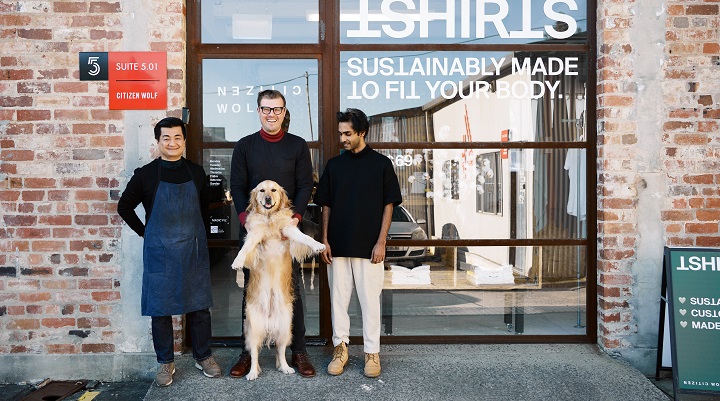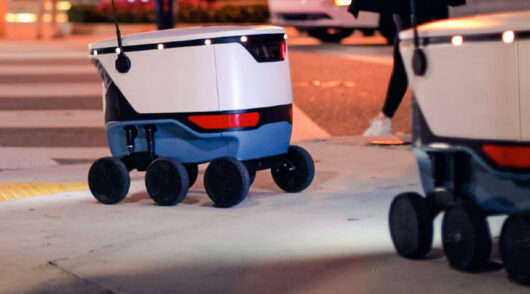Citizen Wolf is on a mission to solve overproduction in the fashion industry by making custom-fit clothing on-demand. It aims to operate ‘micro factories’ around the world that use local fabrics and labour to fulfil orders, and it recently launched an equity crowdfunding campaign to help it take the first step towards achieving this goal.
We spoke with two of the brand’s co-founders – Zoltan Csaki and Eric Phu – about the new campaign, why Citizen Wolf has always been underestimated by the fashion industry and what’s next for the business.
Inside Retail: Tell me about the crowdfunding campaign. When did it launch and how much are you hoping to raise?
Zoltan Csaki: The expression of interest stage opened two weeks ago and runs for another week. We’ve currently got over 750 people who want to invest in Citizen Wolf, which is mind-blowing. We’re planning to raise $1 million.
IR: What do you plan to use the funds for?
Eric Phu: The level of activity will depend on how much we raise, but at the very least, we will use it to develop new products beyond t-shirts and sweats. The most popular request from customers is, ‘When are you going to do more than t-shirts?’ This will help fund that process.
The second thing the money will be used for is to expand the capacity and capability of the factory and technology to make more things and make them faster. If we raise $1 million dollars or more, that will enable us to start testing overseas markets to see which will be the most receptive for our business.
From there, the next stage would be to open up the factory to service that market using local fabrics and local labour.
IR: So, local manufacturing will be a key part of your global expansion?
ZC: We’ve always wanted to do the inverse of traditional fashion in every way, but certainly on the ‘make’ side as well. Rather than have one huge centralised factory in China or Bangladesh, we’ve always envisaged having a series of micro factories around the world in every market.
We probably won’t raise enough money this time around to do that. Our first step into being an international company will be testing those markets and seeing which one performs best from a marketing perspective, so in 12 to 18 months’ time, we’ll be in a position to raise again.
IR: In terms of product development, what categories do you plan to tackle first?
ZC: This winter, we made our first foray out of t-shirts into sweatshirts. That’s been performing really well, and we’re actually on the cusp of launching sweatpants.
Once we get out of winter, we’ll move into shirting, so linen and probably denim shirts. That will be the first time we’ve moved into woven fabrics. We know we need to do that to prove out the technology for non-knitted garments and non-mechanical stretch garments.
For the last six years, we’ve been underestimated by the wider industry as ‘those crazy guys over there making custom fit t-shirts’. But it was never just about t-shirts for us. The way the industry operates is just fundamentally flawed.
Not only does it not work in terms of overproduction, which is the default and is killing the planet, but it doesn’t work for the consumer. On the e-commerce side, there’s this whole issue with returns and what happens to those returns, so the experience is just crap.
What we’ve discovered is that we’re actually solving both sides of the problem. On the supply side, we’re solving overproduction, but on the consumer side, we’re solving loyalty. We have a three-and-a-half times better repeat purchase rate than the industry average and four times lower returns.
So even though we are those crazy guys over in the corner dicking around with t-shirts, there’s always been a bigger play for us – to reengineer the way the industry operates at scale by validating and proving a new way of working. That’s what’s always been important to us, and that’s why this raise is so critical.
IR: Over the past six years, you’ve refined your Magic Fit algorithm to create custom t-shirts based on just three factors – height, weight and age. Will you need to adapt it for different types of garments that have less margin for error?
ZC: Because we’ve made so many t-shirts and put so many bodies through the algorithm, we’re very confident in its accuracy, and we’ve worked really hard over the last year to encourage people to leave notes about their body.
For example, we had a woman the other day who said she used to be on the swim team as a kid, and that’s a very good signal to us that she probably needs an extra two centimetres in the shoulders compared to other women that conform to her height and weight.
Yes, there’s less tolerance with woven fabrics, so that’s where we’re going to be doing most of the work – on the tolerance side and the fit matrix side.
EP: I think it’s important to say that while Magic Fit seems very simple, it is derived from a lot of data points – 196 million to be precise. And it’s actually predictive of your entire body, it’s just that we only use a certain portion of it for t-shirts.
We’ve always had in mind that Magic Fit needed to be capable of more than t-shirts, so as a result, we don’t have to tweak anything on the front end. It’s all about the interpretation of the data, and that’s what we need a bit more R&D on. But the sweats are already proving it is possible.
IR: I know you’re also looking to cut down on the manufacturing time. What is it currently, and where are you hoping to get to?
EP: At the moment, it’s an average of seven to 10 days, depending how big the backlog is. Our goal is to reduce that by at least 30 per cent and to triple our capacity. That’s going to come from two things. One is improving the technology so that it is more efficient, and two is getting some gains through economies of scale.
When we started with one machinist, for example, we could only produce 14 t-shirts a day, if we were lucky. With two machinists, we almost tripled that amount, and with three machinists, we almost tripled that again. So as we build up the team and build up their skill set, there’s just natural scale that comes with it.
ZC: There are actually three layers in our tech stack. Magic Fit is the first layer, and the second layer is Garment OS. It’s the software that powers the factory.
Magic Fit handles your measurements and hands them off to Garment OS, which does the translation into a dynamic pattern and controls the workflow through the factory. The final part of the tech stack is the factory itself – the hardware, the laser cutter and of course, all the seamstresses as well.
So, when we talk about working on the technology, we’re not talking about Magic Fit, we’re talking about Garment OS and the factory.
IR: Are you planning to expand the footprint of the factory itself?
EP: We actually moved to a new factory in Marrickville at the start of the year. It’s four times the size of our old St Peters factory, so we have room to grow. We’re not using all of that capacity at the moment, we’re actually subletting part of it to The Social Outfit. That will also hopefully provide a pipeline of staff, as they train up refugees to learn valuable skill sets in sewing, who we can then hire.
IR: Is there anything else you’re working on?
ZC: A couple of weeks ago, we released a takeback scheme and a recycled fabric made from the scraps that come off our laser cutter, so now we can credibly claim to be 100 per cent circular.
Whenever we make things, we don’t have 100 per cent yield on the fabric, so now we’ll combine that scrap with the t-shirts we take back and send it to Spain, where it will be turned into 50 per cent recycled cotton and 50 per cent virgin organic cotton yarn, which we will reimport and have knitted in Melbourne along with the rest of our fabric.
The story we’re trying to tell is that we can make you a t-shirt today out of any fabric you like; you can wear it for as long as you like, repair it if it fails, and when you’re done with it, you can bring it back, and we can make it into recycled fabric from which we can make your next t-shirt.
That’s always been our ambition. We’ve been zero waste since day one, but the goal was always to get to the point where we can make a new t-shirt from an old t-shirt. This is just a validated blueprint for the rest of the industry – because it’s possible.






